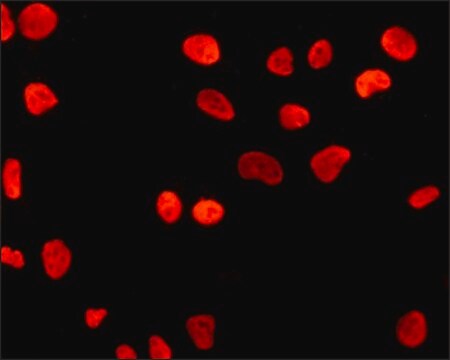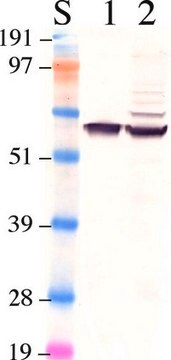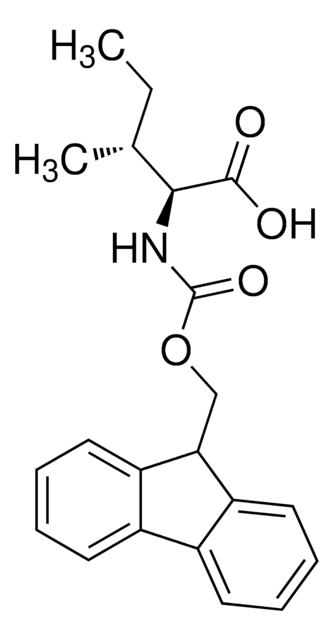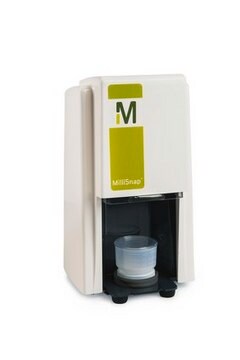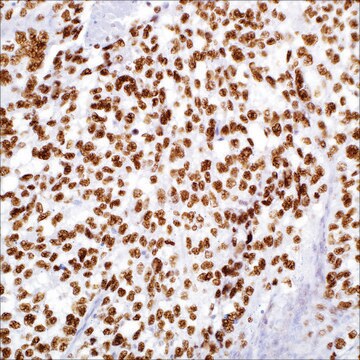MABN2438
Anti-RPE65 Antibody, clone KPSA1
Synonyme(s) :
All-trans-retinyl-palmitate hydrolase, EC:3.1.1.64, Lutein isomerase, Meso-zeaxanthin isomerase, Retinal pigment epithelium-specific 65 kDa protein, Retinoid isomerohydrolase, Retinol isomerase
About This Item
Produits recommandés
Source biologique
mouse
Niveau de qualité
Forme d'anticorps
purified antibody
Type de produit anticorps
primary antibodies
Clone
KPSA1, monoclonal
Espèces réactives
bovine, human, mouse
Conditionnement
antibody small pack of 100
Technique(s)
direct ELISA: suitable
immunohistochemistry (formalin-fixed, paraffin-embedded sections): suitable
western blot: suitable
Isotype
IgG1κ
Séquence de l'épitope
C-terminal
Numéro d'accès Protein ID
Numéro d'accès UniProt
Informations sur le gène
human ... RPE65(6121)
Spécificité
Immunogène
Application
Evaluated by Western Blotting in Bovine retina microsomal preparation.
Western Blotting Analysis: A 1:10,000 dilution of this antibody detected RPE65 in Bovine retina microsomal preparation.
Tested Applications
Western Blotting Analysis: A representative lot detected RPE65 in Western Blotting applications (Golczak, M., et al. (2010). J Biol Chem. 285(13):9667-9682; Banskota, S., et al. (2022). Cell. 185(2):250-265.e16).
Immunoaffinity Purification: A representative lot was used for purification of crossed-linked RPE65.(Golczak, M., et al. (2010). J Biol Chem. 285(13):9667-9682).
Immunohistochemistry Applications: A representative lot detected RPE65 in Immunohistochemistry applications (Amengual, J., et al. (2014). Hum Mol Genet. 23(20):5402-17).
ELISA Analysis: A representative lot detected RPE65 in ELISA applications (Golczak, M., et al. (2010). J Biol Chem. 285(13):9667-9682).
Note: Actual optimal working dilutions must be determined by end user as specimens, and experimental conditions may vary with the end user.
Description de la cible
Forme physique
Reconstitution
Stockage et stabilité
Autres remarques
Clause de non-responsabilité
Not finding the right product?
Try our Outil de sélection de produits.
Code de la classe de stockage
12 - Non Combustible Liquids
Classe de danger pour l'eau (WGK)
WGK 1
Point d'éclair (°F)
Not applicable
Point d'éclair (°C)
Not applicable
Certificats d'analyse (COA)
Recherchez un Certificats d'analyse (COA) en saisissant le numéro de lot du produit. Les numéros de lot figurent sur l'étiquette du produit après les mots "Lot" ou "Batch".
Déjà en possession de ce produit ?
Retrouvez la documentation relative aux produits que vous avez récemment achetés dans la Bibliothèque de documents.
Notre équipe de scientifiques dispose d'une expérience dans tous les secteurs de la recherche, notamment en sciences de la vie, science des matériaux, synthèse chimique, chromatographie, analyse et dans de nombreux autres domaines..
Contacter notre Service technique